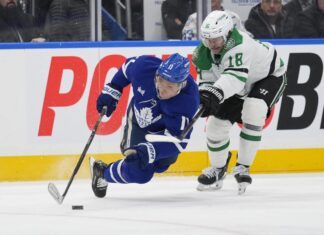We’ve been tracking scoring chances and zone entries for every Toronto Maple Leafs game this year. Now that we’ve reached the halfway point, it’s time for some summary tables and discussion.
If not otherwise specified, all the data is calculated at even strength. Some supporting data used in the discussion is from the excellent Puckalytics, along with my other regular sources, war-on-ice.com and hockeystats.ca, all of which are invaluable when looking at these kinds of numbers.
Note: This data does not include last night’s game versus the Columbus Blue Jackets.
| Team | CorsiF% | ESCorF% | Chance% | ESCh% | ESClCh% | NZ% | ContEnt% |
|---|---|---|---|---|---|---|---|
| Toronto | 51.3% | 49.8% | 50.7% | 48.7% | 49.1% | 49.4% | 39.3% |
| Opponent | 48.7% | 50.2% | 49.3% | 51.3% | 50.9% | 50.6% | 41.0% |
CorsiF% and ESCorF% are the Corsi numbers. Chance%, ESCh% and ESClCh% are the percentage of chances for the Leafs overall, at ES and at ES Close, respectively. NZ% is the percentage of zone entries made by a particular team (not counting clearances where no one is pursuing the puck), and ContEnt% measures the percentage of entries that are controlled (passes or carries).
The Leafs‘ Corsi and chance numbers are similar over the first half of the season; they’ve been essentially even with opponents 5-on-5. While the chance numbers are a little more against them, they are a huge improvement from what we saw last year. For context, last season the Leafs got barely over 45% of chances at ES. The big difference is that the Leafs have allowed substantially fewer chances. From over 17 against per game last season, the Leafs have improved to allow 14 per game this year. Their chances for have also dropped, but by a much smaller margin, as Mike Babcock has gotten his team to play a tighter game. There’s still room for improvement, but it’s beyond any doubt that a lot of progress has been made.
We don’t have old data on zone entries, but these numbers end up paralleling chances as well, with the Leafs narrowly losing the neutral zone. Toronto’s percentage of controlled entries (passed or carried into the zone) is relatively low, under 40%, but they’ve done a decent job of preventing controlled entries against as well, and are only slightly behind in that metric.
Forwards
Below is every forward who has played at least ten games (so no Rich Clune). ES and ESCl% are chance percentages at even strength and at ES Close. NZ% is the percentage of times the Leafs entered the opponent’s zone, rather than the opposite, while a player was on the ice. Pers% represents the percentage of Leafs entries that I have directly attributed to that player. ContEnt and OppContEnt are the Leafs and opponents’ percentage of zone entries that were under control (passed or carried).
| Name | G | AvESTOI | ES% | ESCl% | NZ% | Pers% | ContEnt | OppContEnt |
|---|---|---|---|---|---|---|---|---|
| Van Riemsdyk | 40 | 14:57 | 55.6% | 58.9% | 47.5% | 34.8% | 47.2% | 41.3% |
| Komarov | 40 | 14:06 | 51.5% | 50.0% | 49.7% | 26.9% | 44.0% | 40.0% |
| Grabner | 38 | 10:29 | 50.7% | 45.3% | 51.5% | 23.9% | 36.3% | 39.3% |
| Boyes | 33 | 09:21 | 50.6% | 56.9% | 51.0% | 30.5% | 39.5% | 38.7% |
| Kadri | 40 | 15:39 | 49.9% | 52.3% | 50.5% | 29.0% | 45.6% | 41.6% |
| Bozak | 36 | 14:41 | 49.5% | 48.7% | 46.7% | 20.5% | 43.2% | 41.8% |
| Arcobello | 11 | 08:58 | 49.1% | 51.4% | 50.3% | 19.9% | 34.2% | 33.3% |
| Parenteau | 40 | 13:03 | 48.3% | 49.2% | 47.7% | 26.4% | 39.7% | 40.6% |
| Froese | 30 | 10:32 | 46.6% | 56.3% | 50.7% | 21.0% | 34.1% | 37.8% |
| Holland | 35 | 11:21 | 46.2% | 48.7% | 50.4% | 26.0% | 36.3% | 40.1% |
| Winnik | 37 | 11:59 | 45.8% | 42.9% | 51.5% | 34.8% | 31.1% | 43.5% |
| Lupul | 35 | 12:54 | 44.5% | 43.8% | 49.5% | 27.1% | 31.7% | 40.3% |
| Spaling | 24 | 12:56 | 43.4% | 35.8% | 49.5% | 17.6% | 31.4% | 42.3% |
| Matthias | 39 | 11:25 | 42.9% | 43.4% | 47.5% | 29.0% | 37.2% | 41.5% |
The first thing that stands out is how big a loss James van Riemsdyk is going to be, as he has really thrived this season. I wondered whether his play would suffer without Phil Kessel on his line, but if anything he’s improved. His chance percentage is by far the best on the team. When he was with Nazem Kadri early in the year, that line was the team’s best at generating chances (although that didn’t turn into a lot of goals). When he was moved onto a line with Tyler Bozak, that unit became the more effective offensive threat. He was the forward most likely to be on the ice for a controlled entry, and was the single largest individual driver of entries, with over a third of Leaf zone entries when he was on the ice going through him. The Leafs will have to get improved contribution from others or they will be in trouble, as he looks to be a substantial loss.
It’s interesting to see that Mike Babcock has opted to place Shawn Matthias into Van Riemsdyk’s spot; based on this information, he’s been the worst regular forward on the Leafs in terms of chances. His zone start and competition numbers aren’t particularly impressive either way, and it’s not as if he’s been pinned in his own defensive zone or given brutal matchups. Matthias played with Tyler Bozak and P.A. Parenteau for a time earlier in the season, but that line was not good in terms of chances, and he hasn’t done much on a more defensive line since.
A man who seems to be a more deserving candidate to move up in the line-up is Brad Boyes. Most advanced statistics pick him out as one of the Leafs most effective performers this season, despite limited ice time. He averages fewer ES minutes than any of the other regular forwards, but Boyes leads the team in ES points per minute. One drawback is that Boyes has faced weaker competition than most of the Leafs, but his play is still strong enough that he seems to deserve a shot.
Nazem Kadri has had a good first half of the season — not spectacular, but very solid. He is almost dead even in terms of chance percentage, and, like van Riemsdyk, is among the Leafs’ better players at generating controlled entries. His line with Leo Komarov and Michael Grabner has been reasonably effective, but from a chance perspective he was best with JVR at the start of the season.
As with van Riemsdyk, there were a lot of questions as to how Tyler Bozak would fare without Phil Kessel, and he’s largely vindicated himself. Bozak’s managed to stay near to even in chances and possession. Not to drill it into the ground too much, but he will face the same questions without JVR in the lineup now. In his 270 minutes without JVR, Bozak’s Corsi is no better than last year’s, even as the team has improved around him. Whether he can be as effective with Parenteau and Matthias on his wings is something I question.
Joffrey Lupul has done very little this season. He’s been stuck in fairly difficult situations in terms of opponents, and given relatively weak linemates, and subsequently it’s knocked down his chance and possession numbers. Still, Daniel Winnik and Michael Grabner have both had much better numbers despite having similar statistical conditions overall.
Defence
Again, five games is the cut-off, so no Frank Corrado.
| Name | G | AvESTOI | ES% | ESCl% | NZ% | Pers% | ContEnt | OppContEnt |
|---|---|---|---|---|---|---|---|---|
| Harrington | 15 | 12:22 | 56.8% | 64.4% | 45.0% | 8.5% | 36.3% | 39.4% |
| Marincin | 27 | 11:56 | 51.4% | 51.1% | 49.8% | 9.5% | 36.9% | 36.0% |
| Polak | 38 | 15:41 | 51.3% | 55.8% | 48.0% | 10.7% | 38.0% | 39.5% |
| Gardiner | 37 | 17:58 | 50.1% | 52.0% | 50.0% | 12.5% | 42.0% | 39.2% |
| Phaneuf | 40 | 17:42 | 49.4% | 52.3% | 49.0% | 10.4% | 41.1% | 40.5% |
| Rielly | 40 | 19:00 | 47.8% | 43.1% | 50.6% | 19.2% | 38.6% | 42.5% |
| Hunwick | 39 | 19:00 | 43.1% | 40.3% | 50.0% | 11.8% | 37.8% | 43.7% |
Matt Hunwick has been buried in terms of the opponents he’s had to face this season, and it shows, as he has the worst chance numbers on the team by a fair margin. A lot of the high difficulty minutes that previously went to Dion Phaneuf have been pushed onto Hunwick, along with Morgan Rielly. You can also see that Rielly has outclassed his partner. Despite having similar usage, Rielly has a clear advantage in all possession areas, although he still lags behind the rest of the team. Rielly is also the most likely defenceman on the Leafs to be responsible for the puck entering the zone, although his defensive role means we haven’t seen a lot of scoring from him. Last season, the youngster was one of the best defenders in terms of chances, but that was against weaker opponents, making a direct year-by-year comparison relatively meaningless.
The players that are utilized on the bottom pairing by Babcock also stand out pretty clearly in the table. Scott Harrington, who has been with the Marlies since November, and Martin Marincin, who is preferred to Corrado for that 6th spot, have consistently faced the easiest opposition and been on for relatively few defensive zone faceoffs. They also find themselves on the bench more in tight games, while their regular partner, Roman Polak, continues to get minutes. Marincin has the best Corsi numbers on the back end, but that hasn’t turned into similar results in terms of chances, where he lags well behind Harrington and is only just ahead of Polak. These bottom defencemen have been reasonably effective in their minutes, but whether they can step up if needed is a big question. An injury to one of the more trusted defencemen could make things difficult, increasing the load on everyone and forcing the likes of Marincin and Corrado to show a little more.
Dion Phaneuf has seen his possession and chance numbers make a big turn towards the positive this year, but a lot of that is down to usage, as he’s no longer in such a defensive role. His percentage of offensive zone starts has gone from barely a quarter to over a third, although part of that is down to the Leafs’ overall improvement in that area. He has seen a commensurate improvement in chance numbers, while Phaneuf and Jake Gardiner are the only pairing to manage over 40% controlled zone entries.
We’ve had tough time coming up with anything but good things to say about Jake Gardiner this year, and that continues with this article. He’s been one of the more effective Leafs on the backend and has shown a clear improvement. His chance numbers are better, and his possession stats are improved as well. Unlike Phaneuf, this isn’t due to easier match-ups; Gardiner’s ice time has gotten somewhat more difficult, if anything. This improvement is one of the better developments from the Leafs’ blueline this season.

































